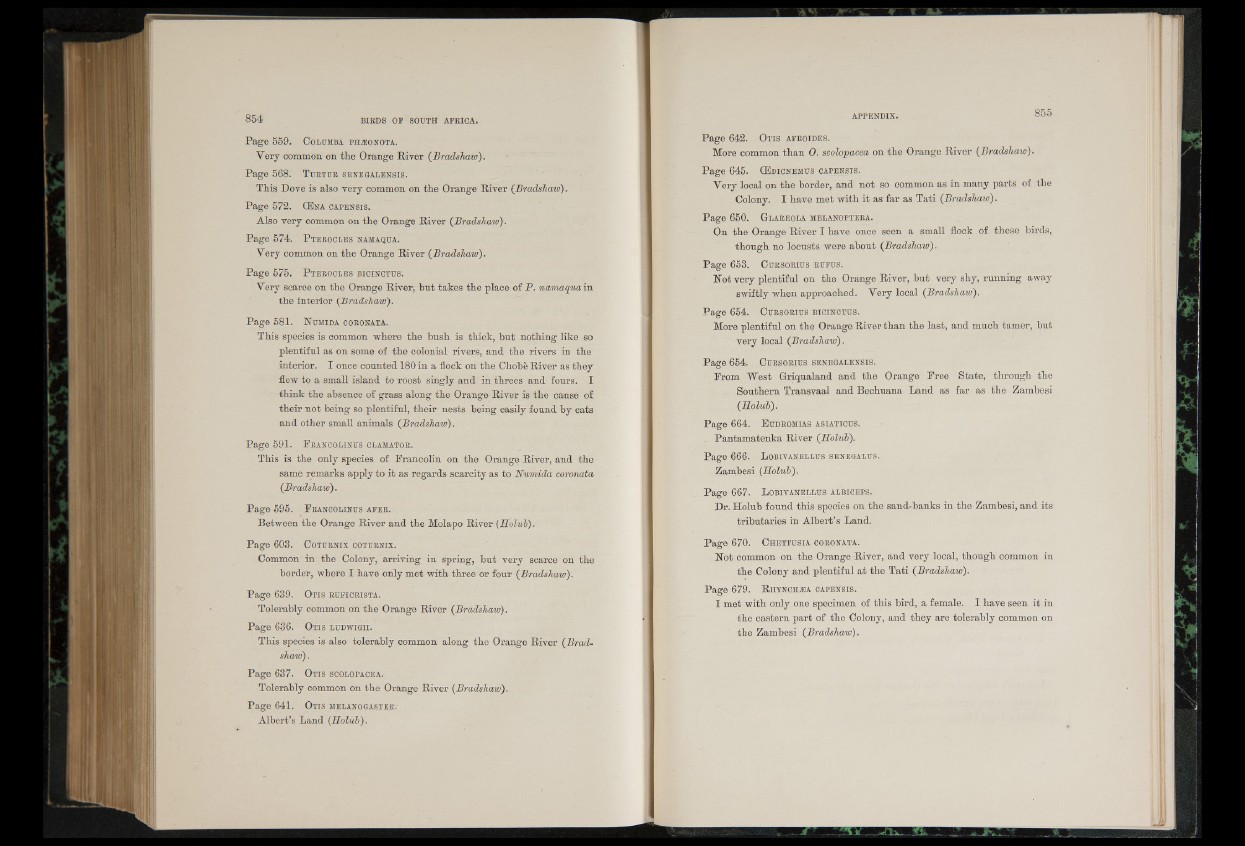
Page 559. C o lum b a p h a io n o ta .
Very common on the Orange River (Bradshaw).
Page 568. T u r t u r s e n e g a l e n s is .
This Dove is also very common on the Orange River (Bradshaw).
Page 572. (Ena c a p e n s is .
Also very common on the Orange River (Bradshaw).
Page 574. P t e r o c l b s n am aq u a .
Very common on the Orange River (Bradshaw).
Page 575. P t e r o c l b s b ic in c tu s .
Very scarce on the Orange River, bnt takes the place of P. namaqua in
the interior (Bradshaw).
Page 581. N um id a c o r o n a t a .
This species is common where the bush is thick, but nothing like so
plentiful as on some of the colonial rivers, and the rivers in the
interior. I once counted 180 in a flock on the Chobe River as they
flew to a small island to roost singly and in threes and fours. I
think the absence of grass along the Orange River is the cause of
their not being so plentiful, their nests being easily found by cats
and other small animals (Bradshaw).
Page 5 91. E r a n c o l i n u s c lam a to r .
This is the only species of Erancolin on the Orange River, and the
same remarks apply to it as regards scarcity as to Numida coronata
(Bradshaw).
Page 595. E r a n c o lin u s a p e r .
Between the Orange River and the Molapo River (Holub).
Page 603. C o t u r n ix c o tu r n ix .
Common in the Colony, arriving in spring, bu t very scarce on the
border, where I have only met with three or four (Bradshaw).
Page 639. O t i s r u f i c r i s t a .
Tolerably common on the Orange River (Bradshaw) .
Page 636. O t i s lu dw ig ii.
This species is also tolerably common along the Orange River (Bradshaw).
Page 637. O t i s s c o lo p a c e a .
Tolerably common on the Orange River (Bradshaw).
Page 641. O tis m e la n o g a s te r .
Albert’s Land (Holub).
Page 642. O t i s a f r o i d e s .
More common than 0. scolopacea on the Orange River (Bradshaw).
Page 645. (E d ic n em u s c a p e n s is .
Very local on the border, and not so common as in many parts of the
Colony. I have met with it as far as Tati (Bradshaw).
Page 650. G l a r e o l a m e l a n o p te r a .
On the Orange River I have once seen a small flock of these birds,
though no locusts were about (Bradshaw).
Page 653. C u r s o r i u s r u f u s .
Not very plentiful on the Orange River, but very shy, running away
swiftly when approached. Very local (Bradshaw).
Page 654. C u r s o r iu s b i c in c tu s .
More plentiful on the Orange River than the last, and much tamer, but
very local (Bradshaw).
Page 654. C u r s o r iu s s e n e g a l e n s is .
Erom West Griqualand and the Orange Eree State, through the
Southern Transvaal and Bechuana Land as far as the Zambesi
(Holub).
Page 664. E u d rom ia s a s i a t i c u s .
. Pantamatenka River (Holub).
Page 666. L o b iv a n e l lu s s e n e g a lu s .
Zambesi (Holub).
Page 667. L o b iv a n e l l u s a lb ic e p s .
Dr. Holub found this species on the sand-banks in the Zambesi, and its
tributaries in Albert’s Land.
Page 670. C h e t t u s i a c o r o n a t a .
Not common on the Orange River, and very local, though common in
the Colony and plentiful at the Tati (Bradshaw).
Page 679. R h y n c h a ía c ap e n s is .
I met with only one specimen of this bird, a female. I have seen it in
the eastern part of the Colony, and they are tolerably common on
the Zambesi (Bradshaw).